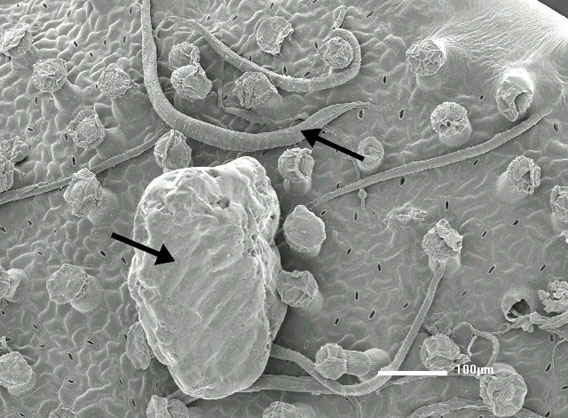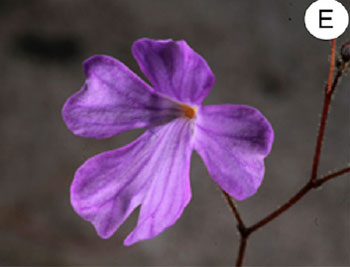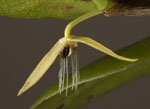
Scanning electron microscope image shows the upper leaf surface of Philcoxia minensis. Arrows point to
nematodes and sand grains.
A worm measuring only a millimeter in length scoots its way through relatively massive grains of white sand. The worm, known as a nematode or roundworm, is seeking lunch in the form of bacteria. Suddenly, however, its journey is interrupted: it is caught on a large green surface. Unable to wiggle free the worm is slowly digested, becoming lunch itself for an innocuous purple flower called Philcoxia minensis.
As bizarre as this scenario sounds, a new paper in Proceedings of the National Academy of Sciences (PNAS) outlines the subterranean predatory behavior of a the Philcoxia minensis in the Brazilian cerrado. Employing sticky leaves that grow under the sand, the flower is able to catch tiny roundworms for sustenance in a low-nutrient environment.
 Philcoxia minensis’ flower. |
In order to prove that the plant was actually ingesting the roundworms, scientists brought Philcoxia minensis into the lab and fed them roundworms containing Nitrogen-15, a stable isotope. After leaving the roundworms to their fate for two days, the researchers sampled the flower’s leaves and had them tested for Nitrogen-15. The test came back positive, proving that the flower had indeed ingested the worms.
The researchers believe the plants have evolved this unique ability—the first time a carnivorous plant has been found employing stick leaves underground—in order to survive its harsh environment.
“Philcoxia minensis is found in relatively low flat areas, where water likely persists after rain. All shrubs and cacti avoid these
areas, although they are common elsewhere in the immediate vicinity,” the authors write, arguing that the plant is able to colonize this area due to its ability to eat roundworms.
Given the new discovery, the researchers believe it’s worthwhile to explore other plant species for hidden meat-eating behaviors.
CAPTION: Caio G. Pereira, Daniela P. Almenara, Carlos E. Winter, Peter W. Fritsch, Hans Lambers, and Rafael S. Oliveira. Underground leaves of Philcoxia trap and digest nematodes. PNAS. 2012.
Related articles
One night only: new orchid species surprises scientists

(11/22/2011) A mysterious new orchid blooms for one night only, opening around 10 PM and closing at 10 AM. Discovered on the island of New Britain near Papua New Guinea, the new species is the world’s first orchid that flowers only at night. Scientists found the new flower, named Bulbophyllum nocturnum, in a logging concession on the tropical island.
‘Luck and perseverance’: new plant genus discovered in Amazon
(03/31/2011) The discovery of a new plant species is not uncommon, especially in places of remarkable biodiversity such as the Amazon rainforest. However, discovering a new plant genus, a taxonomic rank above species, is, according to Henk van der Werff fromt the Missouri Botanical Garden (MBG), “a matter of luck and perseverance”. Researchers with the Missouri Botanical Garden have been blessed with both as they have announced two new species of Amazonian plants, one from Ecuador and one from Peru, that comprise a completely new genus: named, Yasunia, since the plant was originally discovered in Ecuador’s vast Yasuni National Park.
Tiny bats trade in caves for pitcher plants in Borneo
(01/26/2011) A tiny species of bat in Borneo has chosen an unusual roost: a carnivorous pitcher plant, according to a recent study. The study examines how this behavior actually benefits both the bats and the plants, creating a symbiotic relationship.